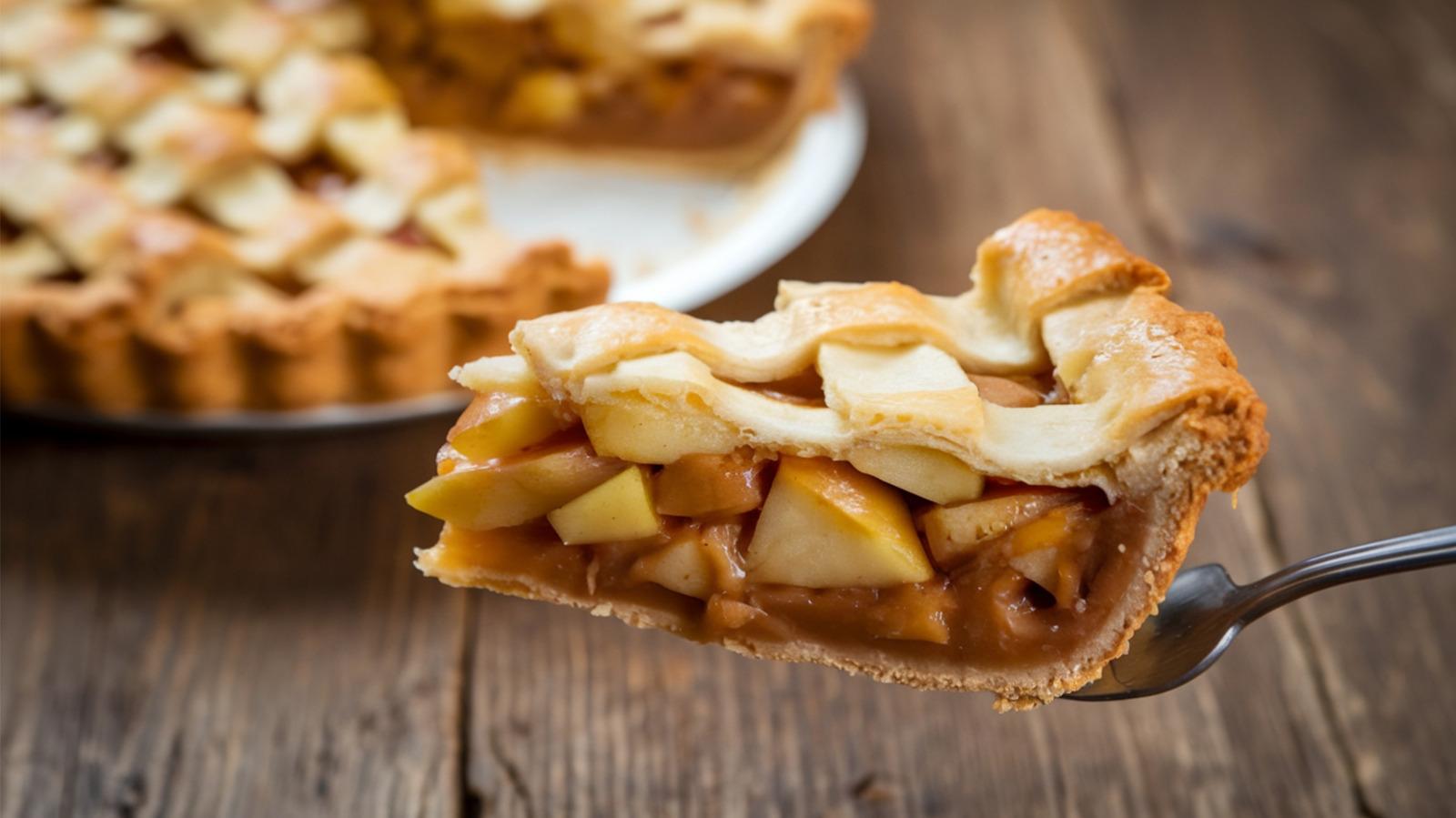
Sham Clicks/Shutterstock
Shopping for apples to make an apple pie these days is like shopping for a car; there are so many viable makes and models on the market, it's hard to know where to start the process. Do you jump in and go with the apples you snack on and love for their sweetness, or is there some sort of mystical process for divining which species will deliver a filling your friends and family will rave about?
The untold truth of apple pie lies somewhere between the two. Bakers who have practiced apple pies most likely started with a recipe that recommended a particular type, then experimented with other apples when it didn't necessarily produce the desired results. Through trial and error, they discovered the type of apple that works best for them. They may have even figured out that a blend of species conjures up the best apple pie possible.
With so much communal culinary knowledge floating around about which types make the best pie apples, it's time to gather all the information in one mostly comprehensive list of which are the worst and best apples for coming up with an incredible pie. Gauging by sweetness, juiciness, and firmness, I've assembled a hierarchy of the best and worst grocery store apples to use for pie baking. Think of it as a literal apples-to-apple comparison that helps you shop for the right fruit for your needs.
15. Red Delicious

New Africa/Shutterstock
Well, they are red, to be sure, but whether or not they're delicious is in question, especially compared to the myriad other species available now. Even as a general use apple, Red Delicious is usually pretty mealy; add heat and any liquid ingredients that might be required in your apple pie recipe, and you're likely to be greeted by a crust full of glop when you take it out of the oven. Another drawback: Many stores stock them as lunchbox apples, smaller in size, which means there could be extra peeling work involved.
Apple pie may be out of the picture for Red Delicious, but some home cooks have had success turning them into apple crisp. The main difference here is the lack of crust in a crisp. You get something closer to baked apple slices with a crunchy topping, potentially a more suitable format for this once-shiny apple.
14. McIntosh
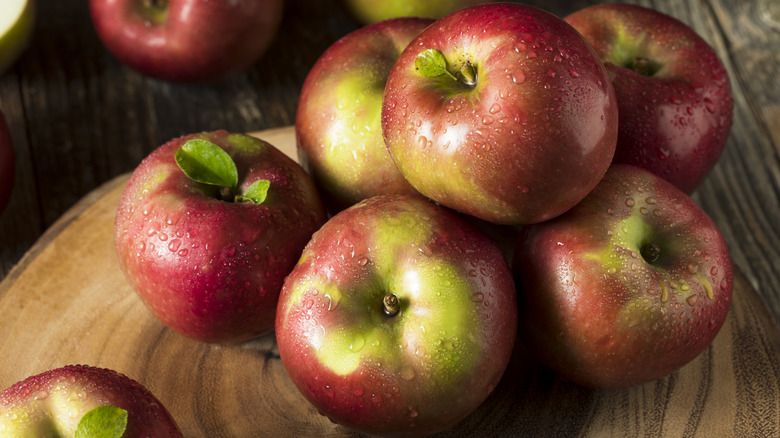
Bhofack2/Getty Images
Old-fashioned McIntosh apples used to be one of the big five, the only apples you could dependably find in the grocery store. The familiar name became synonymous with fruit that was ideal for cooking. But now that so many other types have flooded the market, the truth about McIntosh apples is that the texture turns mushy when heated, ruining the interior of your pie. You may see recipes floating around the web that call for this type of apple, but that doesn't mean you can't substitute a better option.
If you happen to have a load of McIntosh apples on hand but would rather take less of a risk with your apple pie, there's good news: They're great for making homemade applesauce or apple butter, two creations where apples get blitzed into smooth mash as part of the process. Not that you need any extra work added to your culinary schedule, but you could easily put those vintage apples to use instead of trying to eat the whole bushel.
13. Rave
The temptation to include Rave apples in your pie enterprise based on how they taste could be a real problem. This breed has just enough tartness to become one of your favorite snacking apples. It may also be a solid essence to accommodate brown sugar and cinnamon for a nicely balanced medley of flavors, similar to other tart apples on your pie ingredient shopping list. That's almost everything you could want in a pie apple, right?
Well, almost may count in horseshoes, but it's a huge misstep in apple pie making. Regardless of their tempting flavor, the juiciness of a Rave apple makes it too delicate a prospect to work into your plans. The possibility of ending up with applesauce wrapped in pastry dough is very real. The Rave website warns visitors of just this phenomenon and recommends using them only in their fresh form, sliced as snacks, toppings, and finger food.
12. Fuji

Mediterranean/Getty Images
Fuji apples are a favorite among fruit lovers who favor a sweet and crunchy bite. The sugary nature of the fruit means you may need to adjust the amount of sweetener you add to your filling, or squeeze a little extra lemon juice to make sure the flavors meld properly. If you're not a seasoned baker, you might want to steer clear and go with a more cooperative apple, or at least work with two or three types of apples to impart a greater range of apple essences.
If you know what you're doing and are game for tinkering with a recipe that might've already worked for you in the past, Fuji could be your pie apple of choice. They have the quintessential apple spirit that delivers homestyle comfort, but their most desirable quality is that their mid-level firmness helps them keep their shape when baked, especially when cut into larger chunks. The result is a crust filled with tender slices that still resemble pieces of apple when you serve your finished dessert.
11. Opal
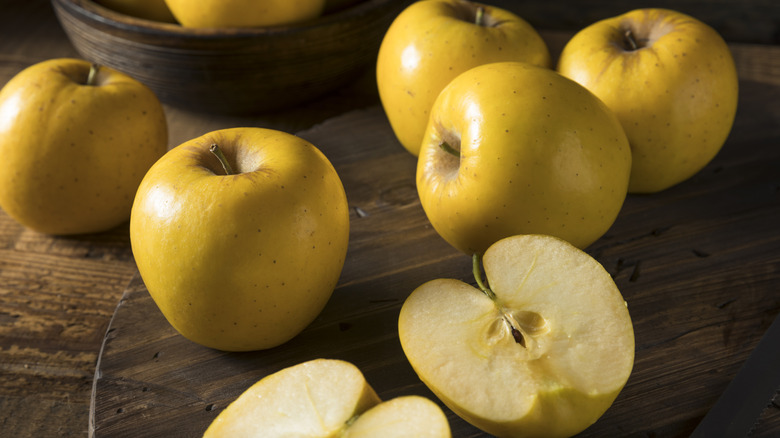
Brent Hofacker/Shutterstock
Opal is another apple with satisfying density that doesn't wilt when trapped beneath a pastry crust in a 350 degrees Fahrenheit oven. Bearing more than just passing resemblance to the flavor of a pear, it may be a little too sweet for a pie, however. To get the most out of your opal apples, you'll probably want to merge them with another type of apple, one with a little more acid to even out the sugary quality. This may seem like a bit of a hassle, but if you're a fan of Opal, it's a workaround that will actually work.
And if you're not so much of a fan? Shop for a more suitable pie apple instead. Even the recipes on the Opal website don't focus on pies, a huge green flag that gives you the go-ahead to skip this breed in favor of something pie fans will appreciate more when it lands on their plate.
10. Cosmic Crisp
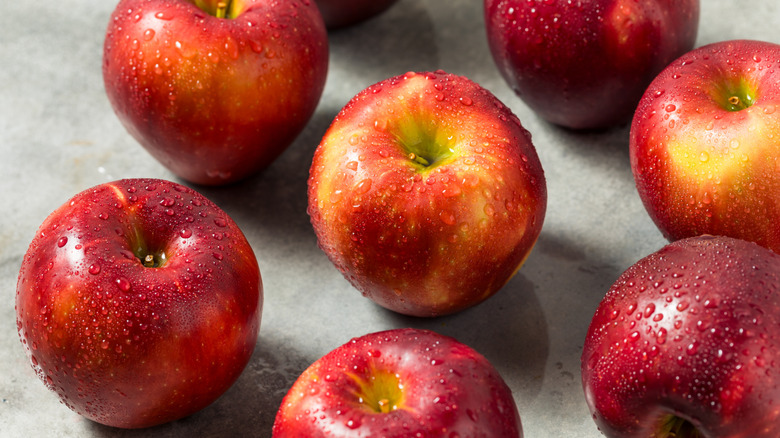
Brent Hofacker/Shutterstock
Similar to the other sweeter apples in the store, Cosmic Crisp is a sweetie that makes a great partner for other, more acidic apples. A blend like this helps distribute the flavors to create tongue-tingling satisfaction. There's also just the right amount of juice for a proper steam, resulting in delicate slices within the crust. It also lends to the syrupy liquid that gives apple pie its gel-like filling.
A great way to test out Cosmic Crisp as part of your pie-making plans is to look for them in the produce clearance section of your grocery store. Many times, if a sale hasn't gone over quite as expected, grocers will bag up several cosmic crisps along with other apple types in a single sack priced at drastically reduced prices. Sometimes you can get several pounds of mixed apples for the same price as a single pound of the more expensive types. This gives you a great opportunity to try cosmic crisp without spending more than you wanted, just in case it doesn't work out to your expectations.
9. Envy
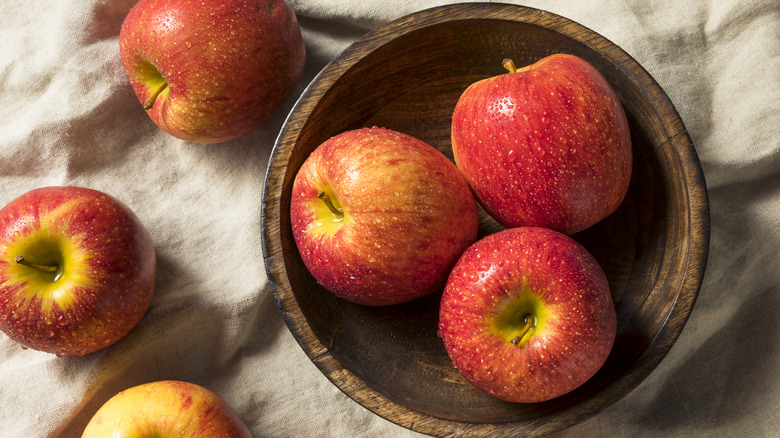
Bhofack2/Getty Images
The highly-coveted Envy apple offers versatility among the apple world; it leads with a balanced flavor that makes for a winner of a pie. It's a cross between a Braeburn and a Royal Gala, capturing the best aspects of both breeds for a mellow apple that doesn't make your teeth ache. The crunch is top-notch, a signal that you can get away with baking Envy without sacrificing too much of its structure.
If you peruse the Envy apple recipe collection, you may notice that the pies mentioned on the website are all open-topped. There may be a good reason for this: The juiciness of the fruit could bring about a soupy fluid interior in a top-crust pie, due to the excess steam that builds up. To give yourself the best chance of a pie that doesn't sag, be sure to vent your top crust enough to allow the steam to escape in the oven.
8. Gala
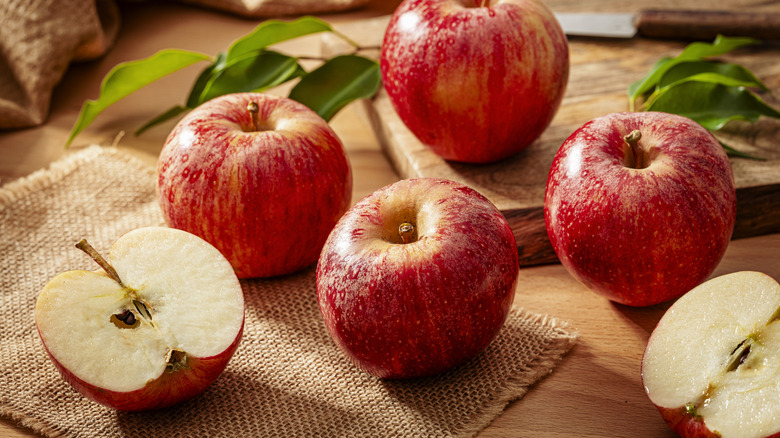
Fcafotodigital/Getty Images
Gala apples seem to be a totally middle ground option for using as a pie filling. Some bakers swear by them as a standalone ingredient, while others use them in a mix with other apples, and some people avoid them due to their softening under heat. You may be able to gauge the firmness of your gala apples as suitable for baking if you've purchased them just before they reach their peak ripeness.
Another yes-no decision to lead your choice of Gala is the sweetness. Some bakers point out the lack of complexity in such a sweet apple, which can mean a pie that can be monotonous. You can always experiment with your spices to ramp up the warm tones in the filling. Should you be a more cautious baker who'd rather not take a chance on flavor, incorporate Gala into a mix with a tart apple so you get a sophisticated blend of tasting notes.
7. Pink Lady

Jlipko/Getty Images
Pink Lady is a more selective type of apple that isn't necessarily available in all areas. If you happen to be one of the regions where the breed is stocked in grocery retailers, you may want to give them a try. Word on the Pink Lady website is that its flesh remains intact when baked, ensuring sliced apples appear when you cut into your pie rather than apple soup sliding through the crust.
You may find them in stores listed as Cripps Pink; they're the same type of apple (Pink Lady is the brand name), so you're safe picking them up with either name on the sticker. With a sweet and tangy personality that shines through, you can stick with just Pink Lady to get a sophisticated pie filling or partner them up with your other favorites to make a taste medley.
Add a new specialty to your apple pie greatest hits with a mini apple pie recipe that shows off the brilliant possibilities of a Pink Lady apple. These individual tart-like pastries use store-bought dough and don't require a top crust for an easier time in the kitchen.
6. Rome
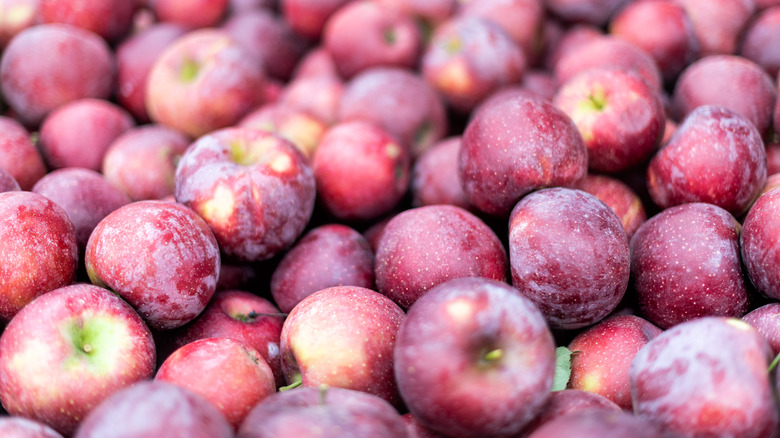
Ablokhin/Getty Images
Rome Beauty apples have a denseness that helps them keep their form when life turns up the heat. That's a key element for a proper pie apple, and one that may even supersede sweetness. You can always increase the sugar in a less-than-sweet apple for the occasion, but you can't make a mushy apple come back together once it falls apart. And since the flavor of a Rome Beauty apple offers a gentle sweetness, it may become your preferred pie apple once you give it a go.
Even if this isn't the most familiar apple in the grocery store, it isn't new by any means. The history-as-legend says it came in a seed shipment to Rome, Ohio in 1817 and was spread through the region by the Gillett family, who got it growing.
Now, you can find Rome Beauty — or just Rome — apples in many larger grocery chains. If you're on the fence about the other apples you've tried and need a new candidate to transform into a sweet and tart deep dish apple pie, they're a worthy purchase.
5. SnapDragon
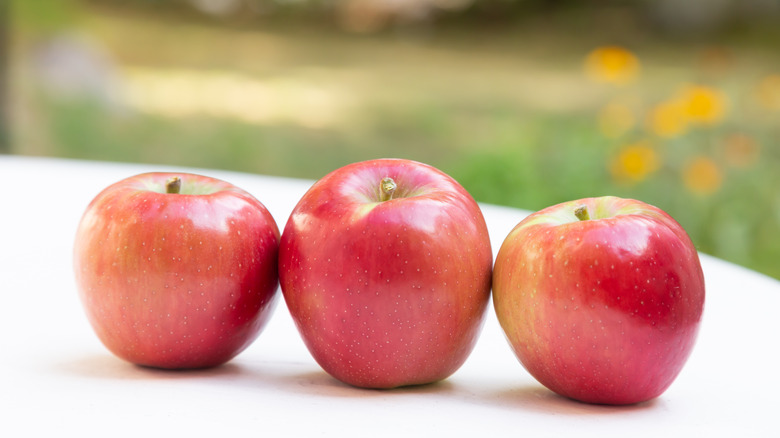
Nancykennedy/Getty Images
SnapDragon is still a relatively lesser known apple, a breed that only appeared in 2013 when Cornell University unveiled them to the world. If you happen to have them in your area, they're a prime candidate for trying in your next apple pie project. They have a firm consistency and a sweet-tartness that make them a good choice. There's also a bit of spice and a little vanilla flavor in the mix, almost as if they've been hybridized to make their own case as pie apples on a molecular level.
The best way to toss SnapDragon apples into a pie is to make them part of your favorite apple pie recipe. If you need inspiration, the SnapDragon website offers a classic version that makes use of the brand's very own fruit. Or you could get a little fancier with a Dutch apple pie recipe, where the top crust is replaced by a crunchy crumble layer that gives extra flavor and a generous serving of fun texture.
4. Honeycrisp

Onepony/Getty Images
As it turns out, Honeycrisp, which are some of the sweetest apples on the market, are a fantastic part of your pie making endeavors. This is a great all-around apple that promises a firm texture and enough sweetness to allow reduced sugar recipes to still deliver definitive apple pie enjoyment. And the larger size of these sometimes massive fruits means fewer apples are needed to make a complete dessert.
There are certain types of apple pies for which Honeycrisp are better suited. One of the surest bets is an open-face caramel apple pie, a mix of juicy apple filling, old-fashioned crumble instead of a top crust, and a generous drizzle of caramel sauce taking the sweet notes into the stratosphere.
If you find yourself with extra slices after your pie filling is complete, wrap scraps of dough around them and turn them into miniature hand pies. Brush the tops with butter, sprinkle with a sugar-cinnamon mixture, and bake them until golden. It'll help you get the most out of your produce.
3. Pippin

Mtreasure/Getty Images
The historic apple with the whimsical name, Pippin apples have been traditionally used in pie-making, favored for their firm flesh and bright flavor. They make excellent ingredients for both crust-topped pies and open face apple tarts, providing quintessential apple essence that even shines through when caramel sauce or chocolate crumble become part of the equation.
The reason Pippin has become one of the go-to apples for pie making may be due to its extensive North American history. This apple was first found in 1759 growing on Long Island, and was grown by founding father Thomas Jefferson. That sort of pedigree has kept them in the consciousness of chefs who appreciate a classic apple persona in their finished pies.
You'll appreciate the tanginess of a Pippin in your pies. Don't let the matte finish of the peel make you believe it's an inferior choice; if you can find these apples near you, your pie making will be all the better for it.
2. Golden Delicious
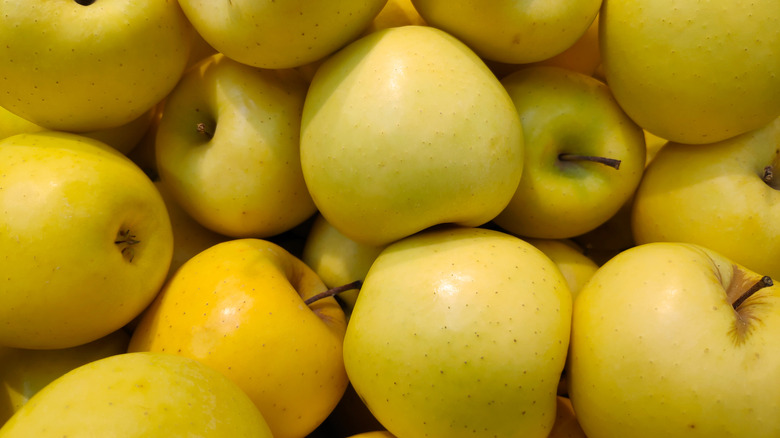
Gwengoat/Getty Images
You can get a lot of high mileage out of Golden Delicious apples, even though they're usually reserved for snacking. The mellow base flavor gives them a cooperative personality for sprucing up with spices, while their sweet overtones ensure an enjoyable pie filling even if you pull back on the additional sugar. While soft, they also keep their shape, holding their own against steamy heat in a top crust pie.
The Today Show heralds Golden Delicious as one of the top options for baking into a pie, as long as they're firm and crisp. Luckily, these apples are almost always crunchy whether you find them in the produce section or a farm stand. As one of the more commonly stocked apples, you'll never come up short if you wait until the last minute to shop for your apple pie necessities. And if your apples of choice aren't available, Golden Delicious will get you through beautifully.
1. Granny Smith
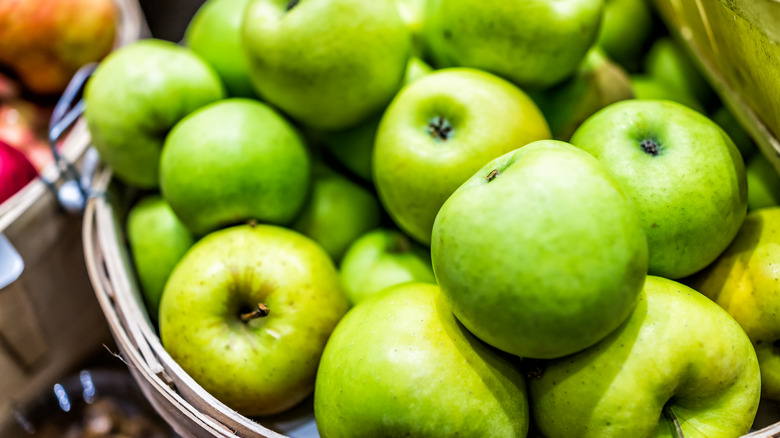
Krblokhin/Getty Images
You've undoubtedly heard boomer bakers explain how Granny Smith was the only proper apple for making a pie back in the day. They aren't wrong; this emerald jewel of the apple world is tart enough to take additional sugar without becoming overly sweet, firm enough to not turn to mush when cooked, and acidic enough to bring bright flavor to pretty much any apple pie recipe. No wonder it's Ree Drummond's preferred apple variety for pie.
Need a little more encouragement to get Granny Smith involved in your pie baking? These vibrant green orbs are high-antioxidant apples, offering a greater concentration of phenols than other apple breeds. They also contain more compounds that don't break down during digestion. This allows the beneficial compounds to assist in creating a healthy gut biome in your digestive tract.
It may be pie in the sky to hope that your finished bake would turn out to be a healthier bite. But using Granny Smith apples gives you the best chance for a mindful dessert that delivers some positive health gains along with premium taste and texture.
How I ranked these apples
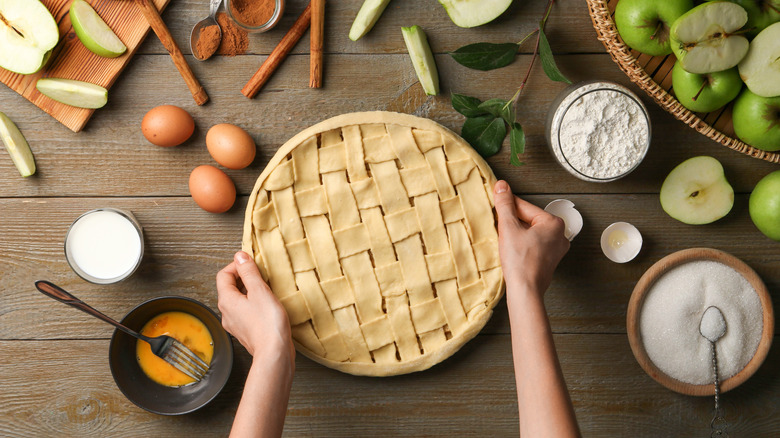
Olga Yastremska/Getty Images
Rather than relying on my restricted experience making apple pies (I always use Gala or Honeycrisp, no matter what the more seasoned chefs recommend), I researched the qualities of each of these apples to determine which make the best pie ingredients. I was always under the impression that a tart apple was the prime pick for a pie, but it turned out that almost any apple can make a suitable pie, as long as it has enough flavor and won't dissolve during the baking process. It made me feel a little better about sticking with my proven apple candidates.
After learning that only a few apples become too soft to make it to the finish line, I arranged the apples based on a combination of taste and texture. Firmer-fleshed types don't rise to the top automatically; they need to hold their flavor when the seasonings are added and not deliver so much juice that it soaks through the bottom crust.
The ideal apple for a pie will result in slices that are soft enough to cut with a fork, with just enough juice to help turn the liquids and sugar into a caramel-like glaze that doesn't leak onto the plate. Should you encounter a too-juicy apple even when using one that seems like a winner, adding a little corn starch or flour can help thicken the sauce while the pie bakes.



